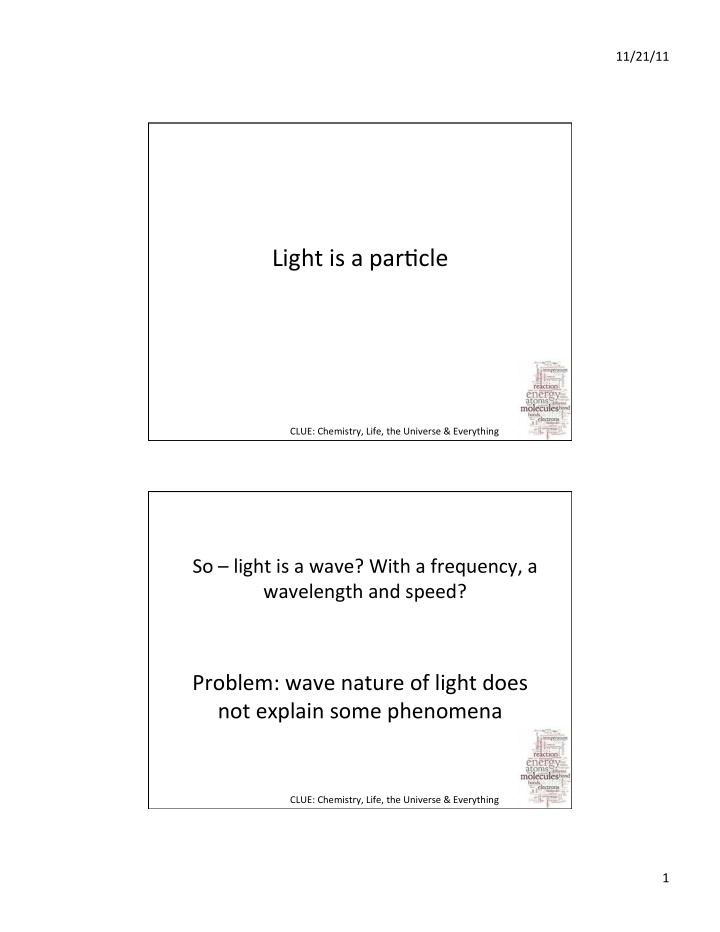



11/21/11 ¡ Light ¡is ¡a ¡par.cle ¡ CLUE: ¡Chemistry, ¡Life, ¡the ¡Universe ¡& ¡Everything ¡ So ¡– ¡light ¡is ¡a ¡wave? ¡With ¡a ¡frequency, ¡a ¡ wavelength ¡and ¡speed? ¡ ¡ ¡ Problem: ¡wave ¡nature ¡of ¡light ¡does ¡ not ¡explain ¡some ¡phenomena ¡ CLUE: ¡Chemistry, ¡Life, ¡the ¡Universe ¡& ¡Everything ¡ 1 ¡
11/21/11 ¡ Black-‑Body ¡Radia.on ¡ ¡At ¡very ¡high ¡temperatures, ¡the ¡ heated ¡object ¡becomes ¡“white ¡ hot” ¡as ¡all ¡wavelengths ¡of ¡visible ¡ light ¡become ¡equally ¡intense. ¡ Fig. ¡7-‑3b, ¡p. ¡276 ¡ Black-‑Body ¡Radia.on ¡ • MaSer ¡emits ¡radia.on ¡(energy) ¡which ¡ changes ¡in ¡wavelength ¡(and ¡frequency) ¡as ¡the ¡ temperature ¡increases. ¡ • Warm ¡blooded ¡animals ¡emit ¡in ¡the ¡infra-‑red ¡ (night ¡goggles ¡see ¡infra-‑red) ¡ • As ¡the ¡temperature ¡increases, ¡the ¡wavelength ¡ of ¡light ¡emiSed ¡does ¡not ¡correspond ¡to ¡ “classical” ¡wave ¡theory ¡ CLUE: ¡Chemistry, ¡Life, ¡the ¡Universe ¡& ¡Everything ¡ 2 ¡
11/21/11 ¡ Ultra-‑violet ¡Catastrophe ¡ The ¡photoelectric ¡effect ¡ 3 ¡
11/21/11 ¡ Photoelectric ¡Effect ¡ • When ¡light ¡shines ¡on ¡a ¡metal ¡surface ¡electrons ¡ are ¡emiSed ¡– ¡crea.ng ¡a ¡current. ¡ • The ¡light ¡is ¡transferring ¡energy ¡to ¡the ¡metal ¡ surface ¡– ¡where ¡it ¡is ¡transformed ¡into ¡kine.c ¡ energy ¡that ¡give ¡the ¡electrons ¡enough ¡energy ¡to ¡ “leave” ¡the ¡atoms ¡in ¡the ¡metal ¡ • There ¡is ¡a ¡threshold ¡frequency ¡below ¡which ¡no ¡ electrons ¡are ¡ejected ¡– ¡no ¡maSer ¡how ¡bright ¡ (intense) ¡the ¡light ¡ • If ¡light ¡were ¡a ¡wave ¡– ¡increasing ¡the ¡intensity ¡ should ¡increase ¡the ¡energy ¡– ¡and ¡eject ¡electrons ¡ E/m ¡radia.on ¡is ¡a ¡ par<cle ¡-‑ ¡Photoelectric ¡effect ¡ • Energy is transferred as a particle (photon) that has a definable energy. • E = h ν ¡ • One photon ejects one electron • If the photon does not have enough energy – then no electron is Photoelectric ¡effect ¡simula.on ¡ ejected 4 ¡
11/21/11 ¡ E/m ¡radia.on ¡is ¡a ¡par.cle ¡(and ¡a ¡wave) ¡ • Planck ¡E ¡= ¡h ¡ ν ¡for ¡the ¡energy ¡of ¡a ¡photon ¡(h= ¡ 6.626 ¡x ¡10 –34 ¡ J.s) ¡ – E/m ¡radia.on ¡comes ¡as ¡packets ¡of ¡energy ¡-‑ ¡ quan.zed ¡ • Einstein ¡-‑ ¡photoelectric ¡effect ¡-‑ ¡does ¡not ¡ depend ¡on ¡the ¡intensity ¡-‑ ¡just ¡the ¡frequency ¡ (energy) ¡ CLUE: ¡Chemistry, ¡Life, ¡the ¡Universe ¡& ¡Everything ¡ What ¡is ¡the ¡energy ¡of ¡a ¡photon ¡of ¡frequency ¡4.0 ¡x ¡10 18 s –1 ¡ (h ¡= ¡6.626 ¡x ¡10 –34 ¡J.s) ¡ A. 2.6 ¡x ¡10 8 ¡J ¡ B. 2.6 ¡x ¡10 –15 ¡ J ¡ C. 1.7 ¡x ¡10 –52 ¡ J ¡ D. 6.0 ¡x ¡10 51 ¡J ¡ CLUE: ¡Chemistry, ¡Life, ¡the ¡Universe ¡& ¡Everything ¡ 5 ¡
11/21/11 ¡ What ¡is ¡the ¡wavelength ¡of ¡a ¡photon ¡of ¡energy ¡ 6.2 ¡x ¡10 –8 ¡J ¡ A. 3.2 ¡x ¡10 –34 ¡ m ¡ B. 3.2 ¡x ¡10 18 ¡m ¡ C. 3.2 ¡x ¡10 –18 m ¡ D. 9.4 ¡x ¡10 25 ¡m ¡ CLUE: ¡Chemistry, ¡Life, ¡the ¡Universe ¡& ¡Everything ¡ A ¡hydrogen-‑hydrogen ¡bond ¡(in ¡H 2 ) ¡requires ¡ ¡ 7.2x ¡10 –19 ¡J ¡of ¡energy ¡to ¡break ¡the ¡molecule ¡apart. ¡ ¡ ¡ ¡ ¡ What ¡frequency ¡of ¡light ¡does ¡this ¡correspond ¡to? ¡ ¡ What ¡is ¡the ¡wavelength? ¡ ¡ What ¡consequences ¡does ¡this ¡have ¡in ¡everyday ¡life? ¡ Ultraviolet ¡radia.on ¡and ¡radia.on ¡of ¡shorter ¡ wavelengths ¡can ¡damage ¡biological ¡molecules ¡ because ¡they ¡carry ¡enough ¡energy ¡to ¡break ¡bonds ¡ within ¡the ¡molecules. ¡ ¡(visible ¡is ¡~ ¡350 ¡– ¡700) ¡ ¡ CLUE: ¡Chemistry, ¡Life, ¡the ¡Universe ¡& ¡Everything ¡ 6 ¡
11/21/11 ¡ Electromagne.c ¡Radia.on ¡ • Can ¡be ¡described ¡as ¡either ¡a ¡par.cle ¡or ¡a ¡wave ¡ ¡ • These ¡are ¡models ¡– ¡not ¡reality! ¡ • It ¡is ¡truly ¡difficult ¡to ¡imagine ¡these ¡ideas ¡– ¡how ¡ can ¡one ¡phenomenon ¡be ¡two ¡different ¡things? ¡ • Wave ¡– ¡par.cle ¡duality ¡is ¡important ¡at ¡very ¡ small ¡scales ¡ • MaSer ¡and ¡energy ¡don’t ¡behave ¡like ¡they ¡do ¡ in ¡our ¡macroscopic ¡world ¡ Where ¡do ¡those ¡photons ¡come ¡from? ¡ Why ¡is ¡light ¡ different ¡colors? ¡ 7 ¡
Recommend
More recommend